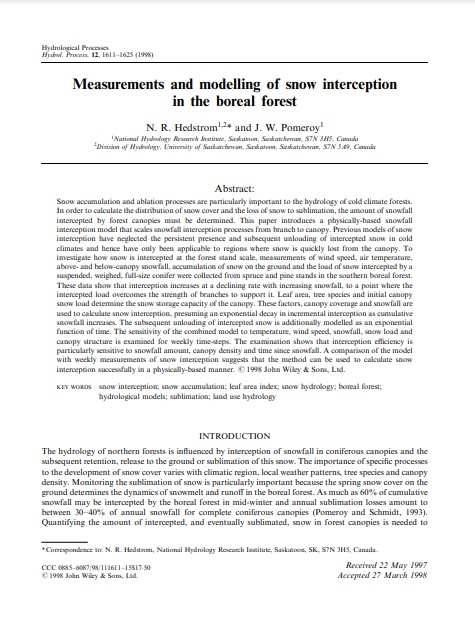Measurements and modelling of snow interception in the boreal forest
Bosque Modelo:
Prince Albert
Temática:
Desarrollo humano
Tipo de documento:
Artículo científico
Resumen
Snow accumulation and ablation processes are particularly important to the hydrology of cold climate forests. In order to calculate the distribution of snow cover and the loss of snow to sublimation, the amount of snowfall intercepted by forest canopies must be determined. This paper introduces a physically-based snowfall interception model that scales snowfall interception processes from branch to canopy. Previous models of snow interception have neglected the persistent presence and subsequent unloading of intercepted snow in cold climates and hence have only been applicable to regions where snow is quickly lost from the canopy. To investigate how snow is intercepted at the forest stand scale, measurements of wind speed, air temperature, above- and below-canopy snowfall, accumulation of snow on the ground and the load of snow intercepted by a suspended, weighed, full-size conifer were collected from spruce and pine stands in the southern boreal forest. These data show that interception increases at a declining rate with increasing snowfall, to a point where the intercepted load overcomes the strength of branches to support it. Leaf area, tree species and initial canopy snow load determine the snow storage capacity of the canopy. These factors, canopy coverage and snowfall are used to calculate snow interception, presuming an exponential decay in incremental interception as cumulative snowfall increases. The subsequent unloading of intercepted snow is additionally modelled as an exponential function of time. The sensitivity of the combined model to temperature, wind speed, snowfall, snow load and canopy structure is examined for weekly time-steps. The examination shows that interception eciency is particularly sensitive to snowfall amount, canopy density and time since snowfall. A comparison of the model with weekly measurements of snow interception suggests that the method can be used to calculate snow interception successfully in a physically-based manner. #1998 John Wiley & Sons, Ltd.
Información Bibliográfica
Autor:
Hedstrom, NR and JW Pomeroy.
Revista:
Hydrological Processes
Año:
1998
N°:
10 . 11
País :
Canadá
Páginas:
1611 - 1625
Volumen:
12
Idioma:
Ingles
Palabras claves
snow interception; snow accumulation; leaf area index; snow hydrology; boreal forest; hydrological models; sublimation; land use hydrology





